#traditional British scones
Explore tagged Tumblr posts
Text
Classic Scones Recipe: Master the British Tradition
Classic Scones Recipe: Master the British Tradition #afternoontearecipes #bestscones #breakfastscones
#afternoon tea recipes#best scones#breakfast scones#easy scones recipe#homemade scones#how to make scones#savory scones#scones recipe#traditional British scones
0 notes
Text
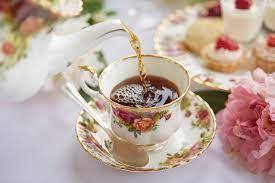
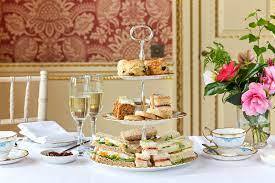
The essence of England: afternoon tea served on Royal Albert china
#Wentworth Woodhouse#Rotherham#South Yorkshire#UK#afternoon tea#Royal Albert#Long Gallery#The National Trust#British heritage#fine china#tradition#hot scones#Georgian
21 notes
·
View notes
Text

@ketchupkio yes I mean the american biscuits & gravy thing, as in the biscuit you guys use to that end is referred to, by itself, as a scone in the south US (I think?), and seems to be a savoury version of the sweet one (of scottish origin) traditionally used in desserts w jam & cream or butter.
correct me if I'm wrong though my only resource on this is google.
let's settle this
rb + say in tags where you're from if you'd like
#i am starting to see weighing in on this may have been a mistake considering the US is so large#& the time since people there established their own traditions has been long enough that those traditions are well established#but yes. scones are originally scottish and are a dessert biscuit and they ARE pronounced 'skon' as in gone if you wanna be accurate#saw an american say they saw british ppl pronounce it how it'd be spelt 'scun' to them and honestly idk what the FUCK that was about
5K notes
·
View notes
Text
Silly idea due to the fact I have the cilantro = soap gene. Expanding off this post I made yesterday. Gonna be a fluffy fun fic with a lil spice at the end.
Tags: fem!reader x Soap Mactavish, blowjobs, cunnilingus
Tagging: @tf141glory because they said they wanted a fic from that joke post

You noticed that Task Force 141 ordered a lot of takeout, though you chalked that up to the grueling work that you all did to keep the world safe. MREs were all fine and good and you noticed each of the men had their own particular food they could cook.
Soap would occasionally cook something called cock-a-leekie soup and the name of the dish never ceased to make you chuckle, much to his enjoyment. You noticed that when you laughed he would always give you a big smile, the corners of his eyes wrinkling ever so slightly.
Price was a traditional British man through and through; the man loved bangers and mash and at one point cooked it every day for a week until you got sick of it and you never saw him without a scone at tea.
You'd asked Ghost what he knew to cook one time and he shrugged, giving you an answer that avoided talking about himself like he always did. But you noticed that next weekend he was in the kitchen making a cottage pie for everyone. You'd given him a little teasing about hidden culinary skills to which he told you the very vaguest parts of his history from when he was a child; the enjoyment he got from when his mum would make this exact recipe. There was a sadness to his eyes as he changed the subject so you dropped the subject.
Gaz was the odd man out in that he didn't really know how to cook, you chalked it up to him being the youngest of the team and lacking experience in that department. But the man was amazing with chips and other friend foods which led you to your current dinner, everyone sat around a table with a big plate of curry chips.
The masala curry was on par with what you'd tried from the local shops which made Gaz's smile bright when you complimented him on it.
"Thanks, mate! Made it myself because I had a wild craving for curry chips and figured I'd share. Never made a curry before that wasn't from a jar but I think it turned out alright, yeah?"
"Yeah, not too spicy either. Y' did good on this one!" Soap was already getting a second helping.
"What, got a weak tongue, Sergeant?" Ghost had been picking at his plate idly with a book in front of him.
"Nae wha' ye tryin' ta imply wit tha', LT?" The accent was getting thick as Soap got more excitable. "I'll have ye know ma tongue is quite strong..." You could've swore he gave you a wink at that. "Just cannae stand heat s'all."
"Hmm." A grunt was the lieutenant's only reply as he spooned some green paste onto the top of his chips before offering it to you. "Chutney? Gaz made some cilantro chutney to go with th' chips. Not bad with th' curry."
Your nose crinkled up at the offering, disgust plain on your face.
"No thanks. I'm one of those genetic weirdos where I got a gene that cilantro tastes like soap."
"Aye an' how d'ye know wha' I taste like, bonnie?" Soap hadn't skipped a beat, and his words brought a flush of red to your cheeks.
"You know that is NOT what I meant!"
Soap smirked at you from across the table and took a chip from his plate, putting some chutney on it and offering it to you.
"Ye keen to find out wha' I taste like, bonnie? Here, have a sample."
You'd finished most of your plate already and figured this was as good enough of a time to excuse yourself from dinner. As you washed your plate you could hear Gaz elbowing Soap in the side with a muffled "Oi now cut that out."
Once you got back to your quarters you just laid in bed staring up at the ceiling. You'd had a crush on each of the guys for different reasons, but you wondered if Soap had noticed. Granted, he was always a flirt when the team went out for some r&r at one of the local bars, but up until now you hadn't really thought of the man as interested in you.
A knock made you look up and you heard Soap's voice from the other side of the heavy door.
"I wanted to apologise, bonnie. Ye still awake?"
"Yeah. Door's unlocked, come in."
Soap stuck his head through the door with an expression you'd never seen on his face before. He looked sheepish and truly regretful as he walked in and shut the door behind him.
"I think I might've taken it a bit far tonight, bonnie. Ye seemed upset after dinner and I wanted ta make sure ye weren't mad at me an' all tha'."
That got a small chuckle out of you and you saw his lips quirk up in the slightest of smiles.
"Nah, we're good, Soap. I'm used to your jokes just, uh, caught me off guard a bit, yeah?"
"Oh? An' how's that?"
He had walked from the door to your bed and sat down at the edge, his hand resting on your thigh reassuringly, the gentle way he touched you made you think about what it would be like to have those hands on other parts of your body.
"Ah, well..." You weren't quite sure how to begin. But you knew the man responded well to blunt talk so you took your chances. "I might actually be interested in what you taste like..."
As your words trailed off you could swear Soap's grin couldn't get any bigger.
"Issat so, bonnie? Well perhaps I'm interested on seein' what ye taste like as well."
The fact that your feelings were reciprocated for him made your heart skip a beat even as you sat there in stunned silence. He had moved a bit closer, his larger frame looming over you.
"Jus' a lil taste, aye? Yer lips, my lips, see where this all goes?"
With a silent nod you leaned in to close the gap between your lips, locking together in a slow, sensual kiss as you felt his strong arms wrap around you. The world seemed to melt away as your tongues explored each other's mouths and truly tasted one another.
After what seemed like a blissful eternity he was the first one to pull away, that smirk on his lips once again as he lightly held your chin in his hand.
"Now tha' I ken what those lips a' yours taste like... how's about we go a little lower, aye?"
His free hand slid up the back of your shirt, unclasping your bra with a practiced ease while you nodded once again. God above you were going to get drunk off this man's treatment of you and you helped him help you to get out of your shirt and bra.
Once topless he pulled back and took a long look at you, letting out an impressed whistle.
"Did nae ken you had such a good body under that uniform, bonnie."
He didn't give you time to reply before his mouth found one of your nipples, teasing and sucking the sensitive nub while his hand gently rolled the other between his thumb and forefinger. Each moan that he managed to work from your lips made the hunger inside him grow and he let out a soft grown when your hands went up to his mohawk and gave it a tug.
"S-soap... I want more... I want to taste you too..."
Pulling away from your breast with an audible smacking of his lips he pressed back on your shoulders.
"Nae yet, bonnie. Dinner was nice but I want some dessert first."
As you laid back he pulled your sweatpants down and off your legs, tossing them aside to some forgotten corner of the room alongside your panties. Strong hands grabbed your thighs and pulled them apart so he could see your already slick cunt, ready and waiting for him. Even as much as he wanted to taste you he wanted to relish in the moment which meant kisses along your inner thighs accompanied by the occasional soft bite to the skin there that would make you whimper in need.
Finally, after he felt you'd been teased enough, he dove in for his treat. Soft lips surrounded your clit as he sucked on it gently, alternating between that and flicking against it with his tongue. Thick fingers slid inside and curled up to rub against your g-spot in time with his tongue.
With his face buried between your legs your hands desperately grabbed onto anything to give yourself leverage as you bucked your hips up against his mouth, finally settling on gripping his short hair to earn yourself another growl from him.
It didn't take him long at all to get you to the edge of climax, you could tell this man not only had experience but enjoyed the act of getting his partner off. Just as you were teetering on the edge he pulled his mouth away to look up at you as his fingers kept pumping in and out of you.
"Aye, tha's it. Good girl. Gonna cum for me, aye?"
And with that his face was back down between your legs and your vision went white as your orgasm finally hit, your moans and whines music to his ears as you rode his face through your climax. Only when the final aftershocks and twitches had worked through your system did he stop and pull away once more, wiping his mouth on his forearm.
"Now tha' I ken wha' ye taste like, bonnie, time for ye to taste me."
You watched as he took off his belt and pulled down his pants just enough to let his cock spring free. He wasn't massive but you knew that taking him in your mouth was going to be a test of your gag reflex for sure, still you matched his cocky grin with your own and crawled over to him as he lay there, idly stroking his length.
A drop of pre rolled down the head and you lapped that up first, finding that this kind of Soap had a better taste than you expected. You wanted more and soon you had your lips wrapped around his head, slowly taking more and more of him into your mouth.
"Christ, bonnie!" His hands rested on the back of your head, fingers clenching as you could tell he wanted you to go further down, to go faster, but you wanted to tease him just as he'd teased you. So you took it slow, tongue gliding along every inch of his throbbing shaft until you finally made it to the base. His hips rolled up to meet your mouth and you finally decided to give him what he wanted.
Your soft mouth was already getting him on edge, though he was fighting against his climax with all his strength. When you finally started to slide up and down his length he swore inwardly that you were going to suck the soul right out of him.
It wasn't just your mouth working him at this point; one hand worked his shaft to stroke it in time with your mouth while your other hand gently massaged his massive balls. They felt pent up and twitched with his growing orgasm until finally he managed to choke out.
"B-bonnie... I'm gonna..."
He couldn't finish his words as a low growl cut his sentence short as he filled your mouth with his warm seed. Rope after rope filled your mouth and you eagerly swallowed it all, paying him back in kind for the pleasure he'd given you.
You only pulled away when he'd started to go soft, both of you breathing heavy in the dim light of your room. Those strong arms of his grabbed you suddenly and brought you up to rest your head on his chest. Soap was an affectionate lover and showed it by peppering your head and face with gentle kisses between words of praise.
"Ye did great, bonnie. So good."
Finally he laid his head back with a sigh and a soft chuckle.
"You tasted amazing, bonnie, hope I managed t' taste even half as good as the heaven between yer legs."
With a satisfied lick of your lips you nodded against his chest.
"Yeah, could get used to having you as dessert more often, Soap."
#soap cod#cod x reader#cod mwii#cod#cod mw2#cod mw2 x reader#cod mw2 smut#soap mactavish x reader#soap mw2#john soap mactavish#captain john price#kyle gaz garrick#simon ghost riley#ghost cod
73 notes
·
View notes
Note
For the top 5 meme, Top 5 favorite recipes to cook/eat? :DD
Yes! Thank you for the ask @qserasera, just going off the top of my head since this does change and I typically only riff and don’t use recipes in my day to day ;)

Starting with Ina Garten’s kitchen clambake since I like it a lot and I’m actually making it tonight! This is a good one and adaptable depending on what I have to make it with (rarely lobster). Picturing some lovely cherry stones from Cape May, NJ, USA.
Great crumpets a la King Arthur
Blueberry scones from Smitten Kitchen
What a great cake! Little variation I’ve found between recipes, and so delicious.
Total green chile stew freak here, love it with hominy but any will do 😭
11 notes
·
View notes
Note
do you think those were traditional english scones bc oliver is british?
it would seem that way. but it looked shitty even for an english scone 😭
4 notes
·
View notes
Photo
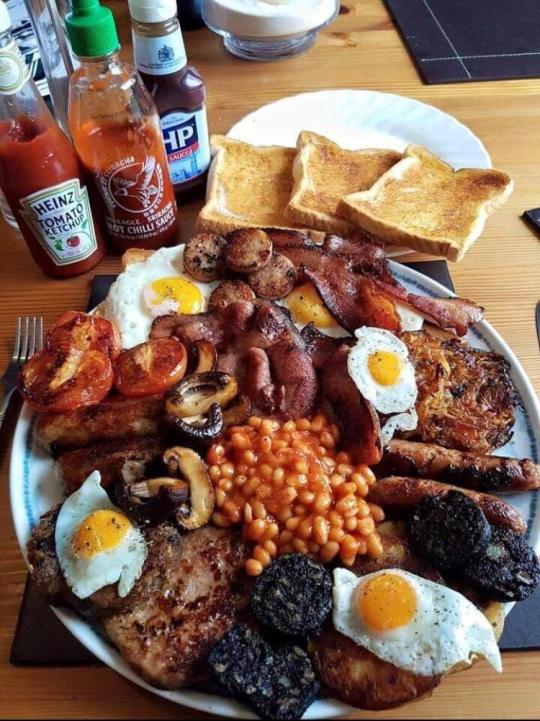
In the name of Bacon will you chicken me up that egg. Shall I swallow cave-phantoms?
- Samuel Beckett, Collected Poems in English and French
I went to a restaurant once that said it served "breakfast at any time" so I ordered French toast during the Renaissance. My waiter got the joke.
What isn’t a joke is the traditional English breakfast as a national institution. Most of us love a full English breakfast; you can even travel abroad, to the Mediterranean resorts in Spain for example, and find this quintessentially British dish on sale in cafes and restaurants.
Sometimes also called a ‘fry-up’, the full English breakfast consists of fried eggs, sausages, back bacon, tomatoes, mushrooms, fried bread and often a slice of white or black pudding (similar to bloodwurst). It is accompanied by tea or coffee and hot, buttered toast. These days, breakfast may also include other items such as baked beans and hash browns.
There are many regional versions of this staple. For example, the Ulster Fry includes Irish soda bread; the Scottish breakfast boasts a tattie scone (potato scone) and even maybe a slice of haggis; the Welsh breakfast features laverbread (barra lawr, made from seaweed); and the Cornish breakfast often comes with Cornish hogs pudding (a kind of sausage).
The tradition of breakfast dates back to the Middle Ages. At this time, there were usually only two meals a day; breakfast and dinner. Breakfast was served mid or late morning, and usually consisted of just ale and bread, with perhaps some cheese, cold meat or dripping.
A lavish breakfast was often served by the nobility or gentry at social or ceremonial occasions such as weddings. A wedding mass had to take place before noon, so all weddings took place in the mornings. The first meal the new bride and groom ate together would therefore be breakfast and became known as the ‘wedding breakfast’.
By Georgian and Victorian times, breakfast had become an important part of a shooting party, weekend house party or hunt and was served a little earlier. The gentry loved to entertain lavishly and that included breakfast.
Breakfasts were unhurried, leisurely affairs with plenty of silver and glassware on show to impress the host’s guests. The breakfast table would groan under the weight of the produce from the host’s estate. Newspapers were available for the family and guests to catch up on the day’s news. Indeed, it is still socially acceptable today to read newspapers at the breakfast table (a definite ‘no-no’ at any other meal).
As well as eggs and bacon, which was first cured in the early 18th century, the breakfast feast might also include offal such as kidneys, cold meats such as tongue and fish dishes such as kippers and kedgeree, a lightly spiced dish from colonial India of rice, smoked fish and boiled eggs.
The Victorian era saw a wealthy middle class begin to emerge in British society who wished to copy the customs of the gentry, including the tradition of the full English breakfast. As the middle classes went out to work, breakfast began to be served earlier, typically before 9am.
Surprisingly, the full English breakfast was also enjoyed by many of the working classes. The punishing physical labour and long hours of work in the factories of the Industrial Revolution meant a hearty meal first thing in the morning was necessary. Even as late as the 1950s, almost half the adult population began their day with a good old English fry-up.
#beckett#samuel beckett#poem#poetry#english breakfast#eggs#bacon#beans#sausage#toast#heart attack#breakfast of champions#culture#society
122 notes
·
View notes
Photo



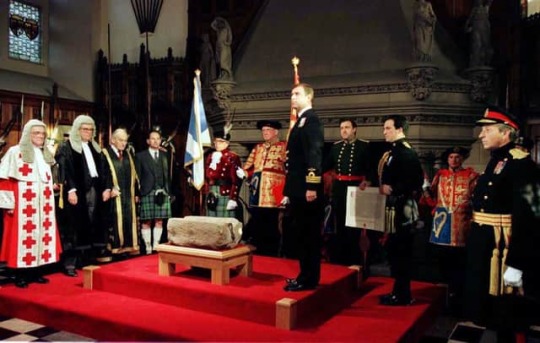




On November 30th 1996 thousands lined The Royal Mile in Edinburgh to see the Stone of Destiny, stolen from Scone by King Edward I of England in 1296, returned to Scotland and installed in the Castle.
At first, the Stone of Destiny appears to be little more than a simple stone, but no other stone could carry so much history and tradition than this one. Despite its simplicity, it has quite a colourful and surprising history.
The Stone of Destiny goes by many names, sometimes called the Stone of Scone, The Coronation Stone , An Lia Fàil or Jacob’s Pillow. It is a simple block of red sandstone that measures about 26 inches by 17 inches.
Both Scottish, English and British monarchs have been crowned on this stone since the ninth century.
Legend dates back to biblical times; the stone is said to have been the pillow Jacob used, where he dreamed of Jacob’s Ladder. It was seen as a sacred object and first went to Ireland and then to Scotland.
No one can pinpoint exactly where the stone came from, with origin stories mentioning biblical stories or the stone being quarried in Scotland. However, geologists proved that the stone was quarried somewhere around Scone, the historical site of the Scottish Kingdom. There is a theory that the Augustine Monks, learning that an English Army was on it’s way to Perth and fashioned a replica from a block of stone quarried nearby, the real stone was either hidden in the River Tay or Dunsinane Hill, my subject of last weeks post, Nigel Tranter himself believed the object Edward took to London was "a lump of Scone sandstone".
As I mentioned in a previous post today, the last Scottish King to receive his coronation on the stone is John Balliol, who is said to have lost the stone to Edward I “Hammer of the Scots” when he invaded Scotland in 1296 The stone was taken as spoils of war where Edward fitted it to his chair in order to try and secure his role as Lord Paramount of Scotland.
In 1328 England promised to return the stone to Scotland. However, angry English crowds stopped it from actually leaving Westminster Abbey. It remained in England for another six centuries.
The stone was liberated by four nationalist students in 1950, during the theft, they broke the stone into two pieces. Despite this, they managed to bring it back into Scotland when they passed both halves to a senior Glasgow politician; the stone was then repaired by a stonemason.
The government ordered a search for the stone, and the search was unsuccessful. The custodians left the stone in Arbroath Abbey in April 1951. When it was discovered, it was returned to Westminster.
In 1996, the government returned the stone to Scotland. A handover ceremony took place in November 1996 between the Home Office and the Scottish Office. It arrived at Edinburgh Castle to a crowd of around 10,000 people. To this day it sits alongside the crown jewels of Scotland when not used in coronations.
Doubt surrounds the stone all throughout its history, and it is said there are many points in which the stone could have been swapped or lost.
Another belief is that the stonemason who repaired the stone after its damage made several copies and the one returned was, in fact one of his forgeries. The big thing, in my opinion that lets this theory down is would a typical Glesga stonemason take the trouble top venture north to Perth to find a lump of stone?
The true history of the stone and whether or not the one in Edinburgh Castle is the correct stone will never fully be known. I myself tend to believe the story, that the Monks hid the original stone.
The Stone will soon be taken down to Westminster Abbey once more and placed on Edward’s Coronation Chair before being returned to Edinburgh, it will then be moved, eventually to the new Perth City Hall museum, the museum is due to open some time in 2024. The last pic is an artists impression of how it could look.
#Scotland#scottish#England#english#stone of destiny#stone of scone#st andrews day#perth#history#medieval history#theft
84 notes
·
View notes
Text
Exploring the Symbolism of Japanese Tea in Art

The Japanese tea ceremony, often called Chanoyu, Sado, or Ocha, is a quintessential cultural practice that goes beyond the simple act of drinking tea. It embodies a rich tapestry of aesthetics, spirituality, and social customs, deeply rooted in Japanese culture. This ceremony primarily revolves around the preparation and consumption of matcha, a finely powdered green tea. The ritualistic nature of the Japanese tea ceremony has not only influenced Japanese society but also inspired artistic representations that encapsulate its profound symbolism.
The Essence of the Japanese Tea Ceremony
The Japanese tea ceremony is a choreographed ritual where matcha is ceremoniously prepared by a host and served to a small group of guests in a tranquil setting. This ceremony is a microcosm of Japanese culture, reflecting principles of harmony (wa), respect (kei), purity (sei), and tranquility (jaku). These principles are not merely practiced but are embodied in the very motions and interactions during the ceremony.
Harmony (Wa)
The tea ceremony fosters a sense of harmony among participants, promoting a deep connection with nature and others.
Respect (Kei)
Every action in the ceremony is performed with respect, from the way tea utensils are handled to the manner in which guests are served.
Purity (Sei)
Purity is symbolized in the meticulous preparation of the tea and the cleanliness of the utensils, reflecting an inner cleansing and spiritual purification.
Tranquility (Jaku)
The ceremony cultivates a serene and contemplative state of mind, offering a respite from the chaos of daily life.
The Role of Matcha in the Ceremony
Matcha holds a central place in the Japanese tea ceremony. This vibrant green tea, made from powdered tea leaves, is whisked into a frothy consistency and served in a handmade tea bowl. The preparation and consumption of matcha are not only about enjoying the tea itself but also about appreciating the moment, the setting, and the company. Matcha symbolizes the Zen principles of simplicity and mindfulness, essential to the tea ceremony's meditative aspect.
Tea Rituals Around the World
While the Japanese tea ceremony is a profound cultural practice, tea rituals also hold significant places in other cultures around the world. Each culture imbues tea rituals with its own unique traditions and meanings.
Chinese Tea Ceremony (Gongfu Cha)
In China, the tea ceremony, known as Gongfu Cha, emphasizes the art of brewing tea to achieve the perfect balance of flavor and aroma. This ritual involves a series of precise steps and the use of special utensils to enhance the tea-drinking experience.
British Afternoon Tea
In the United Kingdom, afternoon tea is a social event characterized by the enjoyment of tea accompanied by finger sandwiches, scones, and pastries. It symbolizes a leisurely and refined way of life, emphasizing elegance and hospitality.
Moroccan Tea Ceremony
In Morocco, the tea ceremony involves the preparation of mint tea, often sweetened and served in ornate glasses. This ritual is a gesture of hospitality and friendship, reflecting the cultural importance of community and sharing.
Indian Chai Ritual
In India, chai is a staple beverage, and its preparation involves boiling tea leaves with milk, spices, and sweeteners. The ritual of making and sharing chai reflects the warmth and vibrancy of Indian culture, emphasizing the importance of hospitality.
The Symbolism of Tea in Art
The symbolic significance of tea, especially within the Japanese tea ceremony, has profoundly influenced art across various mediums. Artists often explore themes of simplicity, tranquility, and mindfulness, drawing inspiration from the tea ceremony's aesthetic principles.
Painting and Calligraphy
Traditional Japanese paintings and calligraphy often depict scenes of tea gatherings or the utensils used in the ceremony. These artworks capture the serene and contemplative nature of the tea ceremony, highlighting its spiritual and aesthetic dimensions.
Ceramics and Pottery
The creation of tea bowls and utensils is considered an art form in Japan. Artisans craft each piece with meticulous care, imbuing them with a sense of individuality and beauty. The imperfections in these handmade items are celebrated, symbolizing the wabi-sabi philosophy of finding beauty in imperfection and transience.
Literature and Poetry
The Japanese tea ceremony has inspired countless poems and literary works that reflect on its deeper philosophical meanings. These works often explore themes of ephemerality, mindfulness, and the interconnectedness of all things.
Conclusion
The Japanese tea ceremony, with its rich symbolism and cultural significance, transcends the simple act of drinking tea. It embodies a philosophy of life that values harmony, respect, purity, and tranquility. This profound tradition has not only shaped Japanese culture but has also left an indelible mark on art, influencing creative expressions that capture its essence. As we explore the symbolism of tea in art, we uncover a deeper understanding of how this humble beverage can connect us to the world and each other, reflecting a universal language of peace and mindfulness.
https://matcha.muragon.com/
5 notes
·
View notes
Text
PT.1
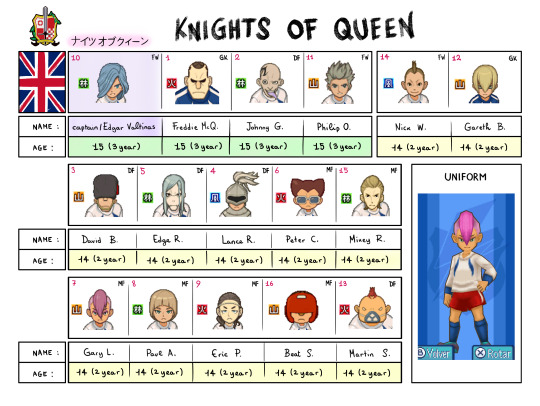
1) Freddie McQueen: "Rages that he will enter into the MI6 as a spy in the future."
2) Johnny Gascoigne: "He might dress and act like a punk, but deep down he's a real softie."
3) David Buckingham: "Royal family enthusiast who buys anything with a royal warrant."
4) Lance Rotten: "Clinging to the rights and privileges of the aristocracy, he asserts his right to lead"
5) Edge Ripper: "A heavy metal vocalist. He is popular enough to perform abroad at his age."
6) Peter Cole: "A music buff who insists that the British music scene is the best in the world."
7) Gary Links: "The scones he makes are perfect in any English tea!"
8) Paul Appleton: "He wants to form a band that will go down in history, but members don't gather."
9) Eric Purpleton: "An expert of tennis that was said to compete at Wimbledon. He went to soccer due to wrist injuries."
10) Edgar Valtinas: "A quiet, brave leader. One of the best players who has both ability and popularity."
11) Philip Owen: "He wants to succeed in English cooking and prevent anyone from saying that it's absolutely bad."
12) Gareth Barrett: "Born in the house of a butler and is an expert at entertaining people."
13) Martin Squall: "He worked well to take care of a horse who had successfully won a Derby!"
14) Nick Woodgate: "He's seriously thinking about opening a school for wizards."
15) Mikey Richards: "There is no junior high school student who exceeds him by the knowledge of suits and the technology of tailoring."
16) Beat Smash: "Sometimes makes a mistake by touching the ball with his hand because he is good at rugby."

1) Thorsten Berger: "His family are brewers, but he prefers a nice glass of Apfelschorle."
2) Alexander Hausen: "This player always acts logically, no matter what kind of situation he's in."
3) Heinrich Fritz: "Because of his strange hobby of sharpening knives, he is often mistaken for a baddy."
4) Kurt Zabel: "If he doesn't get his daily portion of Kartoffelsalat, he's got no energy."
5) Luka Schmitt: "He is big on tanks and goes around tank museums in Europe."
6) Theodor Ulrich: "His civilized manners and steel temperament make him the German model athlete."
7) Jan Oldeno: "Since he thinks that Germany's technical strength is the best in the world, he goes around recommending German products to people."
8) Niklas Kuster: "People call him "Niklas of Blitzkrieg" due to him breaking through opponent's lines with his speed."
9) Jonas Polak: "His dream is to go on a manned flight to Mars with a rocket that he made."
10) Maximilian Milatz: "He believes that German wine is the best in the world, but has never drank wine."
11) Peter Nimke: "He loves German poetry and always carries a collection of poems by Heinrich Heine."
12) Gerald Enders: "He can't wait to pass his test and get behind the wheel of a smart German motor."
13) Erwin Völz: "He is interested in ecology more than anyone else and keeps in mind to always act earth-friendly."
14)Jens Hoffmann: "He is studying to be more of a composer than Beethoven in a music school."
15) Ernst Frodeno: "He's from Breman, but is driven to distraction by caterwauling farm animals."
16) Manuel Ewers: "An accomplished sausage maker who keeps his team well supplied with protein."

1) Nasser Mustafa: "Powerful tribal clan's son. He is said not to come back until he wins the tournament."
2) Far Farouk: "Good at making cakes by processing the fruit of a date palm."
3) Bjorn Kyle: "A boy who seems to live in the shadows. He pulls the team with high mobility."
4) Djamel Djammadu: "He is trying to aim the country to be less reliable on oil and more focused on tourism."
5) Musa Sirer: "This player wants to improve Qatar's manufacturing base and diversify."
6) Yusuf M'hadi: "This player deeply respects tribal traditions, and wouldn't like to live away from home."
7) Sulai Sulaiman: "He is thinking about a method to have seawater to freshwater cheap for everyone in Qatar."
8) Seiyd Armand: "This player is concerned that his country's economy is dependant on oil exports."
9) Messer Jassim: "This player is an expert at finding natural pearls. They're pretty pricey these days."
10) Zack Abdullah: "Best among the tribes in taking care of camels. He seems to hear anything that the camel says."
11) Majidi Ismail: "A master at catching monitor lizards in the desert. However its better not to show a girl."
12) Talal Hamad: "His dream is to enter the Middle East's best TV station and send news to the world."
13) Hassan Ahmed: "This forward is known as the Eagle of Qatar for his swooping attacks."
14) Khalfan Jibril: "This player is keen on preserving ancient mosques, and the fine arts of the Middle East."
15) Rajab Ismail: "He is going to make a novel about Qatar's social problems so it can appeal to everyone."
16) Adel Siddique: "He wants to make a popular movie that is loved by everyone in Qatar."
#brockenborg#knights of queen#inazuma eleven#desert lion#ffi#idk if that's just me#but it's always unnerving trying to find all the info#in one place#so i made this#hope it can be helpful for references for fanfictions#fanarts#etc
14 notes
·
View notes
Text
I'M BACK FROM LONDON!
Hello everyone! So here's what I managed to see/do in these few days: DAY 1 Westminster Bridge Big Ben Palace of Westminster Westminster Abbey Victoria Tower Gardens St. James's Park Buckingham Palace Victoria Memorial The Mall 🍜 spicy noodles and skewers in Spitalfields Market (lunch) 🐟🍟🍺 fish&chips and beer in a traditional pub (dinner) ✔️ took a picture with a red telephone box 💳 bought my oyster card for 7£; to go around for 3-4 days you need to top-up around 15£-20£ 💡tip! download the Tfl Go app, it will help you figure out which line to take if at first you don't understand the map (just consult it before you enter the underground, 'cause there's no signal down there) DAY 2 London Eye Southbank Skate Space BFI Southbank Royal National Theatre Tate Modern Garden Shakespeare's Globe William Shakespeare Mural (❤️) Winchester Palace Golden Hinde Southwark Cathedral London Bridge Monument to the Great Fire of London Tower of London Traitor's Gate Tower Bridge More London Blackfriars Bridge St. Paul's Cathedral Waterloo Bridge West End 🍔🍟cheese burger and chips in Borough Market (lunch) 🍗🍟chicken kyiv and chips in a traditional pub in Covent Garden (dinner) 💡tip! Sainsbury's Local is a chain of convenience store you can find all around the city, so if you forgot to bring something in your suitcase or just need to buy bottled water, you can go there DAY 3 Golden Jubilee Bridges Trafalgar Square Savini | Criterion Heddon St (Ziggy Stardust Plaque) Baker Street (221B) Sherlock Holmes Museum King's Cross The Harry Potter Shop at Platform 9 ¾ British Museum (went inside) Russell Square Tavistock Square Gardens 🥓english breakfast in our hotel 🍜 roast duck noodle soup and spring rolls in Chinatown (lunch) 🫖 afternoon tea at the Morton Hotel
💡tip! an afternoon tea can be a good alternative to dinner if you have to be somewhere early in the evening (many theatre shows start at 19); mine had a pot of tea, different sandwiches, scones, grapes, macarons, chocolates and a mousse, we were really full after it! 🎭🎫 saw Pygmalion at The Old Vic (loved it, ☆☆☆☆☆) DAY 4 National Gallery (went inside) National Portrait Gallery (went inside) 🥓english breakfast in our hotel 🍕the best pizza ever at a pizzeria near Trafalgar Square 🌡️I was so lucky, it basically never rained the entire time I was there. It was really cold tho (3° at one point!) so if you go mid-october, be sure to pack at least one scarf and a warm coat. I want to thank once again everyone who helped me plan my trip. ^-^ Now I hope this list can help others, feel free to message me anytime you want!
13 notes
·
View notes
Text
World building and theories of Engage
Dishes of Brodia
The dishes of Brodia come in these categories:
Celebratory dishes - Sour cream congee
Cheap recipes which can use leftovers or cheap ingredients - meat pie.
Preserving recipes - oatmeal
Exotic dishes - chicken tomato curry.
Crisp bread - Crispbread can also be known as 'Glasgow morning rolls' or 'Scottish rolls'. They are very light and airy, and very, very crispy on the outside. Some people prefer almost black and in very odd differing shapes. The lifespan of these rolls is 24 hours so they must be eaten fresh. Some people eat them for breakfast while others make sandwiches with them. They are not the healthiest dining option but they are a well loved Scottish tradition. People make hot filled rolls with them which can include: square sausage, black pudding, bacon, potato scone or egg. Sometimes they are eaten with a very thick layer of butter. They can be made easily and cheaply which makes them perfect common folk food.
Sour cream congee - Congee is normally made with rice so I believe that this recipe is closer to rommegrot rather than congee. Rommegrot is a traditional Norwegian recipe meaning 'sour cream porridge '. Romme means 'sour cream' and grit means 'porridge'. It has a thick consistency and is often eaten with butter, cinnamon, sugar or cured meats. Traditionally it was eaten at celebrations including weddings and births, however it was not uncommon for peasant families to eat a plain version several days a week as a staple part of their diet.
Crepe pancakes - The recipe is very similar to Scotch pancakes. In some parts of Scotland they are known as 'dropped scones'. They are different to French and English crepes because they are smaller, thicker and slightly risen. Traditionally they were eaten before lent to use up ingredients to avoid waste. The common folk would make them to use up ingredients before they spoil.
Jam cake - This recipe seems to be based on Albert cake. This came has a short crust pastry base, jam and a light and fluffy sponge. It was a cake created in the Victorian era and made after Queen Victoria's husband, Prince Albert.
Tree cake - This recipe is for Sakotis ('Tree cake) which is a layered cake made on a spit. It is a celebration cake which takes a lot of time to make. It is often decorated with sugar iced flowers or chocolate. This is not an everyday cake in Brodia, unlike jam cake and crepe pancakes.
Fish Dango - Dango is a species of fish but the recipe doesn't suggest that it is a recipe solely for this species. The recipe suggests this is battered fish, a popular dish and chip shop meal. You will find a fish and chip shop in every high street in the UK. The original recipe comes from Spanish and Portuguese Jews. In the 15th century Judaism was outlawed in Spain during the Spanish Inquisition. The Jews fled to Portugal. In 1496 King Manuel I mandated the expulsion or baptizing of Jews. The Jews fled to the UK where they introduced their version of fried fish. The Jews preferred their battered fish cold. It is a way to preserve fish.
Cheese wedge - This is just a big slice of cheese. Random cheese fact; the British are the most lactose persistent population in the world. Cheese was an important source of animal protein in the diet of mediaeval commoners, for people who could not afford meat, it was the only source. The byproduct of a cheese wedge could be used to make whey cheeses.
Oatmeal - This is a porridge recipe. Oats have been grown in Scotland since late medieval times. There was no way to preserve oats, so they were turned into a paste and stored in a wooden drawer. The paste porridge would be eaten for a few days until it hardened, then it was eaten in thick slices.
Baked potato - Potatoes, also known as 'earth apples' changed from being an exotic ingredient only nobles sampled in the 16th century to a household staple in the 18th century. Generally it was recommended to serve them with butter or cream.
Nut compote - Candied nuts could be an alternate name for this dish. Compote comes from the Latin word 'compositus', meaning 'mixture'. In medieval medicine it was believed that sugar syrup balanced out the effects of humidity on the body. At a feast compote would be served at the beginning of the last course of a feast.
Traveler's egg - This is a recipe for Scotch egg. There is debate about the origins of the Scotch egg, Yorkshire and India are two of the potential origins. From the name 'Traveler's why's I gather the origin of choice is that it was created by luxury food sellers Fortnum & Mason in 1738 as a quick and convenient snack for city folk travelling to their country homes.
Chicken tomato curry - This dish could be a reference to Chicken Tikka Masala. The origin of the dish is debated, but it is believed that spiced recipes were developed in both England and India thanks to the spice routes. In medieval times, spices helped make aging meat more palatable. In medieval Europe spices were considered an exotic ingredient purchased by the affluent, likewise in Brodia, spices would be a luxury traded commodity from Solm.
.
Haggis - Medieval manuscript calls it 'hagese'. When cattle drivers were taking their cattle to market, rations were made from any available ingredients and stored inside a sheep's stomach. When an animal was slaughtered, the nobleman would let the butcher keep the offal. I can imagine haggis being taken down mines when mining operations would take several days.
Crumble cake -This recipe can also be called 'crumb cake'. Fruit cakes were popular because they could be kept for many months.
Marinated herring - Herring was a very important fish in Medieval Europe. Great Yarmouth, the port of Copenhagen and development of Amsterdam were founded due to herring fishing. The marinate would help but fermented and spoilt fish palatable.
Meat pie - This recipe is a reference to 'Scotch pie'. In medieval times ours were known as 'pyes'. In royal courts they were used to entertain, an example of this can of merriment is live birds hidden in a crust that fly out when the pie is cut into. For the commoner, pies were a way of using and preserving meat and vegetables
9 notes
·
View notes
Note
Do you have a dish or recipe you're very traditional about? Like "it was good 200 years ago, it's good now, no notes"
OHHHHH man. This question is actually harder to answer than you'd think!
Because CONCEPTUALLY, no. I am a person who believes in, mostly, culinary boundaries being pushed, being fucked around with. I am not one of those people who believes that for something to be adapted is to be inferior or fake--I think American Chinese food, Tex-Mex, and British Indian food are all FUCKING BANGERS, they just happen to be different from what I'm going to call their "source cuisines" (I am not even going to go into how saying they aren't 'real X food' erases the efforts of immigrants in a different country, and also ends up flattening, in the above examples, EXTREMELY fucking diverse countries. Like I am not super up on China or India in a culinary sense, only in a passing one, but I do in fact know quite a bit about Mexico and uh there are absolutely places in Mexico that use dairy jesus fucking christ) but they are heroes in their own right.
I also think that tweaking something comes from a place of interest, usually, and desire to make something interesting, or to make something work, or to push your neighbors and family. So, like, I know everyone lost their minds about GBB's smores incident, but, even as a protector of the idea that American Culinary Traditions are Valuable, I think it's really annoyingly precious to be like "A digestive is nothing like a graham cracker" oh ffs shut up I have told people in the Uk to sub in digestives a zillion fucking times they are like 2% different you are being a fucking weirdo. (In the same way the internet LOSES IT when I say most scones are essentially US cream biscuits, but if I put them both on a plate and said "One of these is a scone recipe and one is a cream biscuit" most people couldn't do better than 50/50 quit being stupid who do you think BROUGHT IT OVER HERE)
So, again: Conceptually I do not necessarily believe in culinary sacred cows.
CONCEPTUALLY.
In the real world, in which I am forced to square with my belief structure and its consequences, I was once served an Old Fashioned in Scotland with SELTZER WATER in it, and despite Glasgow being King of the Scottish Mainland I GASPED AUDIBLY but the woman at my hotel (that I highly recommend to anyone staying in Glasgow, which I actually preferred to Edinburgh) was so kind and sweet and delivered it to my room so I DRANK IT, and I have since discovered that there are some people who actually think this is a correct way to make an Old Fashioned and unless you are using the rotgut they made in the South during prohibition you have no business and no right and I hope you know you are unraveling the fabric of society.
15 notes
·
View notes
Note
to the prev anons credit they did say scones but with flavor which is an apt way of describing it to the british
if britbongs could conceptualize "their own traditional cuisine + actual flavor", we wouldn't be mocking them for having shit food in the first place
32 notes
·
View notes
Note
Some chef Sirius questions for you if you please!
Does Sirius have a signature recipe? Something he really likes to make for his loved ones?
How did Sirius learn to cook? Is he good at baking too?
If he had a favorite fast food place, Muggle, what would it be?
What would he think of American biscuits and gravy?
Does he have a favorite kind of cuisine?
Thank you! You're a Sirius superstar!
I can imagine that a roast chicken dinner is his signature. He is super picky about his ingredients and does extra things like brining the chicken.
He first learned to cook when he got his own place and got sick of living on toast and burnt eggs. Then he found a cookbook in a shop and at first he enjoyed the thrill of doing houseelf work (his mother would be horrified at the thought of a Black cooking) and then he found he enjoyed it for its own sake.
As a Londoner he would enjoy a chicken shop. Chicken shops (as we call them) are fried chicken establishments that are found everywhere in london. They are worryingly cheap and often name themselves after random American states, like Alaska Fried Chicken.
Biscuits are odd to brits-they are similar to scones which are usually sweet.
I can see him liking traditional British food and Indian curry.
4 notes
·
View notes
Text
Oh hey, Master! Hellooooooo!

Nemo Baker here! How are you doing?
Oh? You're checking our Faerie Britain records? That's good, that's good! It was a very memorable play, wasn't it? Erm, sorry, Sion's theatrics must have rubbed off on me.
You know, Britain has a... Not unwarranted, mind you, bad reputation in culinary circles. But their baking traditions are pretty solid!
Have you ever heard of a Bara Brith? They're this Welsh bread speckled with fruits. If you like fruity cakes and bread, there also is the Dundee Cake, favorite of the Queen of Scots, the Singing Hinnies, with their wonderful song as they begin sizzling, and many more!
We also have Victoria Sponge Cake, Scones, Madeira Cake... If you go savory, you can't go wrong with good old Shepherd Pie!
Also, besides the things we expect and know from Proper Human History, I heard Faerie Britain had an uniquely developed chocolate culture!
All that is to say...
I REALLY WANTED TO GOOOOOO!!!
I'm a baker, ok!? I wanted to check recipes and expand my repertoire and maybe take in an apprentice or two! BUT DA VINCI GOT TO DO ALL THAT!!! And I was stuck on the Storm Border! Uaaaaaaaaah!!!
... eh? Next time we go to a British Singularity, you'll be sure to take me along? You mean it!? Yay! Thank you, Master!
Oh, but look at this. I made you listen to me complain on and on, and even got a favor from you. Alright! Lay it on me, Master! Do you have anything you'd like me to bake? It's only fair, to thank you for your support.
... Welsh Cakes? Pice ar y maen, the cakes on the stone. Hehe, they're the favorite of quite a few in our crew. Very well! A super large serving, coming right up~!
10 notes
·
View notes